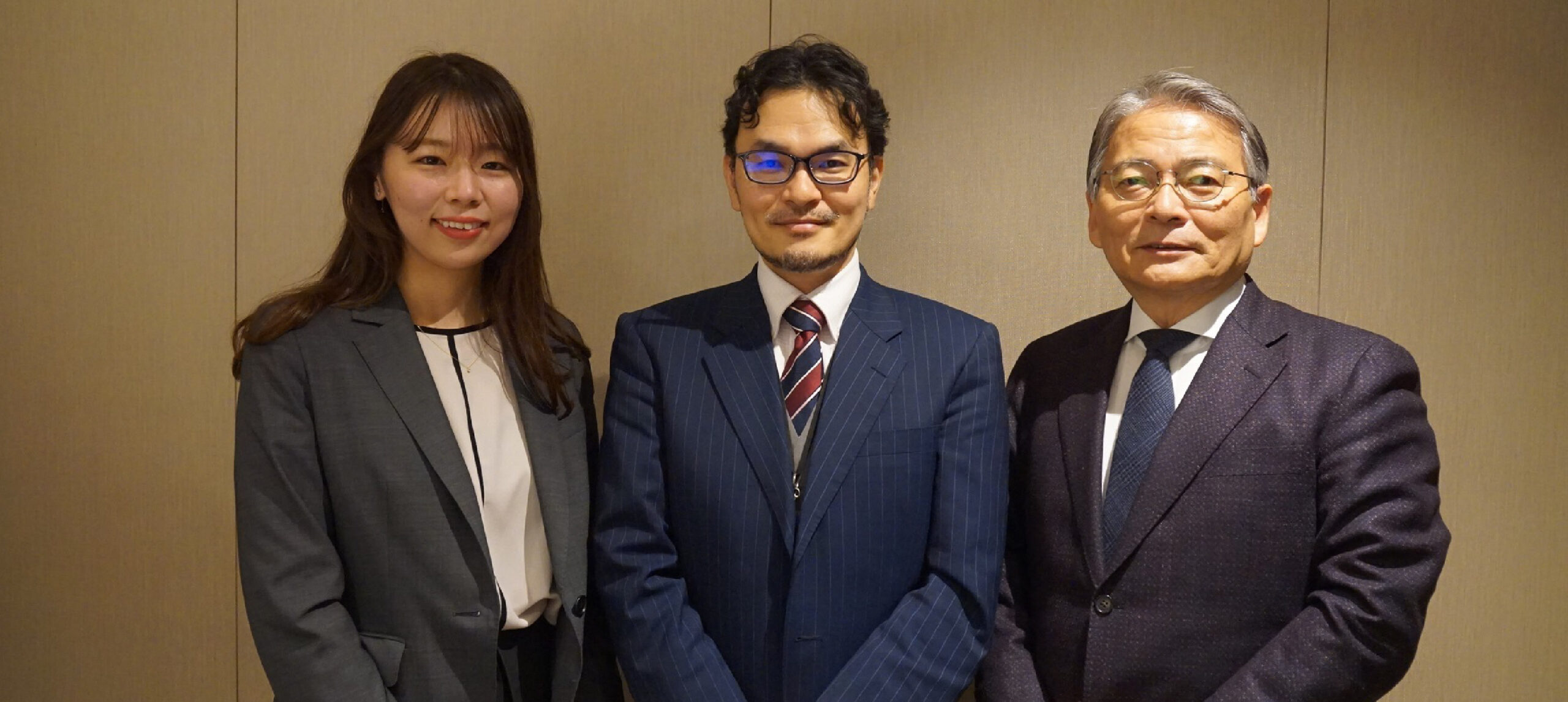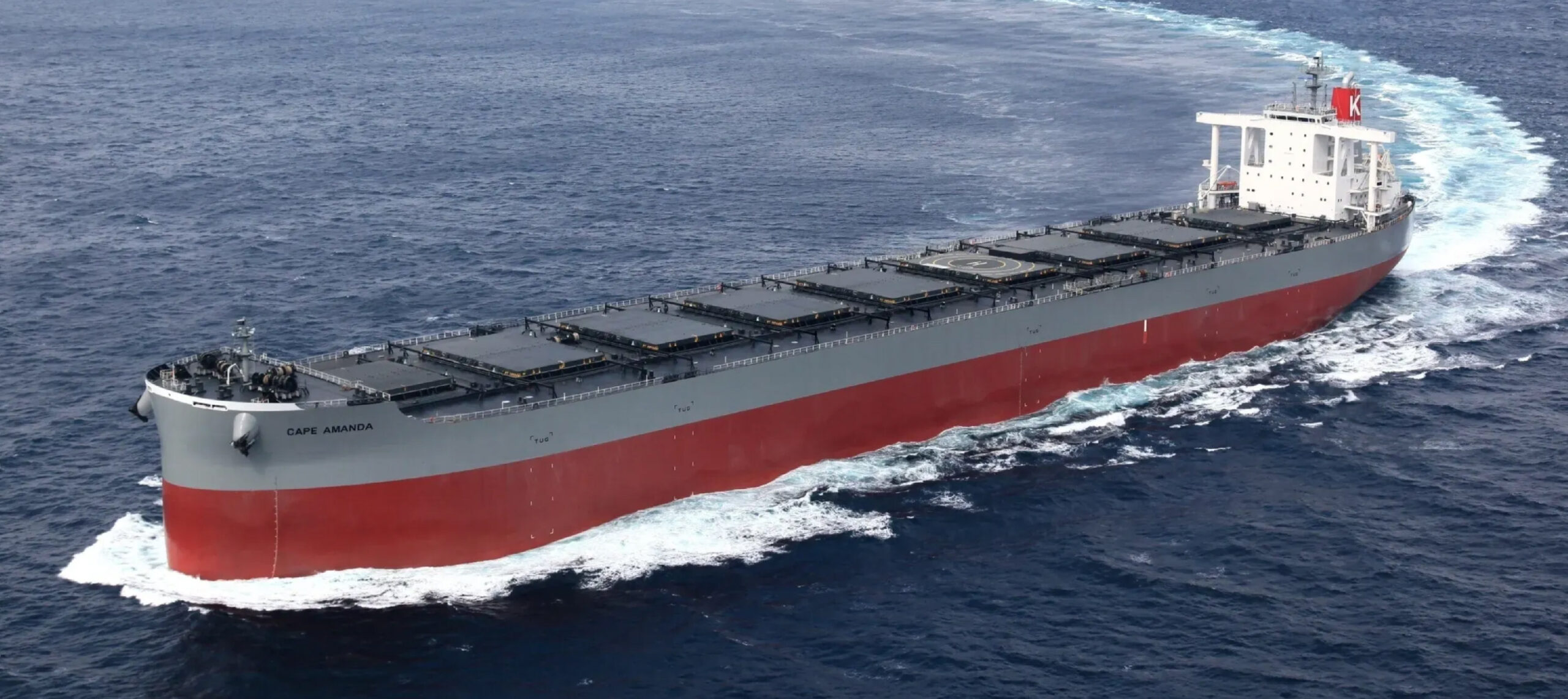Veson Nautical’s dry bulk commodity trade flow analysis tool has been garnering attention. Developed by Oceanbolt, which Veson Nautical acquired in 2021, this digital solution has been adopted by the world’s leading dry bulk shipping companies. Major Japanese shipping companies, research institutes, and educational institutions have adopted the system as well. Kawasaki Kisen Kaisha’s (K-Line) Drybulk Planning Group Project Team, which Kohei Morita leads and Kanoko Ogino is a member of, started to make full use of Oceanbolt’s services in April 2022. Tokio Mitsuda, Country Manager of Veson Nautical Japan, asked the two about the background and goal for introducing Oceanbolt’s service to K-Line in this two-part interview.

Mitsuda: First, please tell us about the functions and role of the Drybulk Planning Group.
Morita: K-Line’s dry bulk carrier business consists of three groups. The Drybulk Planning Group exists alongside two sales groups—one for the coal and iron ore business, which handles capesize bulk carriers, and one for the bulk carrier business, which handles small and medium-sized bulkers. The overall operating fleet consists of 180 vessels.
The Drybulk Planning Group plays a back-office role in supporting chartering and operations through several activities, including providing information that contributes to decisions regarding capesize or small- or medium-sized bulk carriers, and handling revenue and expenditure management for the group. There are three teams in the group—the Project Team, Asset Management Team, and Administration Team.
The main task of Project Team is to analyze the dry bulk market from a macro and micro perspective through information research and marketing. The team is aware that it views the market from a different perspective and angle than the chartering staff, who interact with cargo owners and brokers on a daily basis.
Mitsuda: Please tell us why you adopted Oceanbolt’s service, which makes it possible to visualize dry commodity trade flows in real time.
Morita: Around the mid-2010s, it became necessary to strengthen K-Line’s information research function. This was because it was assumed that it would be difficult to maintain the business as it would be impossible to respond to changes in the business environment without taking on a certain amount of risk. To do this, it was necessary to focus on collecting, analyzing, and utilizing an even greater volume of information.
The scope of our business has rapidly expanded on account of China’s strong appetite for resources. At the same time that commodities and vessels become more like general products, the entry barriers to the shipping industry were lowered. There was also a pronounced shortening of the term of maritime contracts. It became clear that relying on past experience and intuition would no longer work.
Therefore, we sent staff to the research departments of overseas ship brokers and commodity traders. This was done to learn what they look at and how they analyze that information. By accumulating such knowledge and know-how, we gradually expanded the scope of our research and analysis method.
From a relatively early stage, we began utilizing automatic identification system (AIS) data to analyze vessel movements. This led to various insights into how competitors operate their fleets and the distinguishing characteristics of our own vessel allocation. However, AIS data is not tied to commodity information, and we began to feel that there were limitations to analyzing AIS data alone. In the late 2010s, software that could also track commodity trade flow began to appear on the market, and we adopted such products though, there were problems since these products did not offer sufficient data granularity and quality.
We started to use Oceanbolt’s service on a trial basis in 2021. Despite being a latecomer as a provider of commodity tracking services, Oceanbolt’s service was well built for the task. The service is very convenient and attractive to operators at shipping companies.
Mitsuda: What do you think about the advantages of Oceanbolt services?
Morita: The service offers three advantages. The first one is the quality of the data. The AIS data is extremely accurately linked to commodity data. The second one is API integration, or the connection between applications for sharing some functions. This makes it easy to integrate Oceanbolt’s services with other systems. The third advantage is the solid after-sales service.
For a major bulk commodity such as iron ore, it is only necessary to check AIS data and the loading and discharging ports. But when it comes to minor bulk, it is difficult to distinguish the various types of commodities using AIS data alone. If we know details such as who manages the berth, it is easier to identify the commodity.
Ogino: The information provided by the web application offers one perspective provided by Oceanbolt, but in fact, there is a vast amount of data behind it. We can import that big data into our database. This allows us to slice and dice Oceanbolt’s data in the way we want to see it. This is groundbreaking.
Mitsuda: In many cases, users make the most of Oceanbolt’s service with Veson IMOS Platform (VIP), a voyage management system for shipping companies that we provide. Leading dry bulk carrier operators, such as Pacific Basin Shipping Ltd., Ultrabulk A/S, and J. Lauritzen A/S, have introduced the system. Did that also encourage your company to adopt the service?
Morita: We did not pay any attention to what competitors were doing but made our decision based solely on whether it was necessary for us. We want to secure a competitive advantage by taking the lead in digital transformation (DX). We would also like to support the decision-making of our sales representatives. We were searching for the right tool to realize these goals. I think we were able to find the tool that we really needed.
The market intelligence platform developed by Oceanbolt combines information on approximately 14,000 berths where dry bulk carriers make port calls with automatic identification system (AIS) information of approximately 12,000 dry bulk vessels. It utilizes machine learning based on proprietary algorithms to achieve highly accurate trade flow analysis. It tracks more than 140 types of commodities, including iron ore, coal, grains, and nonferrous metals, amounting to more than 5 billion metric tons per year.

Data-Driven Decision-Making: Data Quality and Granularity are the Key
Mitsuda: How do you use the service provided by Oceanbolt to visualize the trade flow of dry bulk commodities?
Morita: We have about 100 employees in our dry bulk business, which includes those at overseas offices. The Oceanbolt licenses have been provided to three groups—the Coal and Iron Ore Carrier Group, Bulk Carrier Group, and Drybulk Planning Group—as well as to overseas offices.
At the moment, there are many cases where chartering staff use the service. For example, after a vessel carries COA cargo from Japan, we examine whether it is possible to expand the options for return cargoes, which reduces the number of ballast legs, and when chartering a vessel from the market, it is possible to screen candidate carriers based on their port call history and related information.
Until now, tonnage lists provided by brokers were used to find suitable carriers, but it is impossible to determine the quality of vessel management from only the name and age of the carrier. With Oceanbolt’s service, we can instantaneously narrow down potential carriers to a few or so, allowing for negotiations with the shipowner to quickly begin.
Mitsuda: Do you use it for market analysis?
Morita: The Drybulk Planning Group mainly uses the service for market analysis. We can view various commodity trade flows of dry commodities quarterly or monthly. We have been working to improve the accuracy of the analysis by increasing data granularity, narrowing the geographic area covered, and reducing data by combining it with several factors.
Ogino: In addition, data is shared throughout our entire dry bulk business. As the number of people who see the data grows, the number of insights that can be gained from the data increases. We have imported Oceanbolt’s vast amount of data into our database and created a mechanism to visualize the data on our business intelligence (BI) tool. This makes it possible to share data in a timely fashion.
Using the UI design for Oceanbolt’s web application as reference, we have been devising ways to present data on the BI tool based on interviews with sales representatives and others. A major future challenge is how to utilize big data and create added value.
Mitsuda: I also think the best part of this service is the extent that Oceanbolt’s data can be imported into your own BI tool and utilized. This capability is also highly rated, and the service has been adopted by Japanese research and educational institutions engaged in such activities as marine transportation research and development. Finally, please tell us of any requests you have for Oceanbolt.
Morita: I think that use of the service would expand dramatically if it became possible to link vessels and commodity, and then also connect it to information of the end user, charterers. Some of Oceanbolt’s competitors have demonstrated strength in linking charterer information.
The service is quite rare because of the quality of the data. Linking information on vessels, commodity, and charterers would probably transform the service into one that would be difficult for competitors to imitate.
Ogino: When I can’t extract data I want, I contact Veson’s help desk. We look forward to product updates based on user feedback, including requests for improvement. We would like to cooperate as much as possible.
Morita: We are not IT specialists, and to be honest, it is difficult to perfectly communicate our requests in English using IT terminology to foreign software and system service providers. I think one of Oceanbolt’s major strengths is that they accept requests in Japanese. After ascertaining the information, they pass it on to the system development staff.
Mitsuda: How is K-Line moving forward with the digitalization of its operations and trying to increase its corporate value through digital transformation?
Morita: We have introduced Kawasaki Integrated Maritime Solutions (K-IMS) to collect and utilize operations and performance data of the vessels. There are also examples of business-related initiatives, such as the development of an artificial intelligence (AI)-based app to measure draft, automatically create stowage plans, and automate laytime calculations. We have already decided to introduce Veson’s voyage management system, the Veson IMOS Platform (VIP).
Ogino: One element of our DX strategy is to promote the use of external data sources. This project is one successful example of reducing data processing time and introducing a system for real-time data analysis and sharing by linking Oceanbolt data to BI tools through API. Using Oceanbolt’s services, we can read signs of change in recent vessel movements and cargo movements. It can be used to provide information to customers besides internal stakeholders. We want to enhance the core value of the team by continuing to support the decision-making of internal and external stakeholders.



 Brian Berry
Brian Berry
 Meagan Eccleston
Meagan Eccleston
 Martin Balestra
Martin Balestra